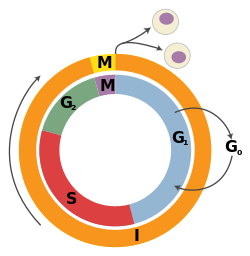The Cell Cycle
(Redirected from Cell Cycle)
The cell cycle consists of two main phases – time of cell proliferation and time of DNA replication and mitosis. Cell cycle works like a chain, so every part of it has its own time and place, which is influenced by the previous step. If some mistake occurs, the cell cycle is stopped on special places called checkpoint controls (G1 and G2).
Parts of Cell Cycle[edit | edit source]
The cell cycle can be divided into two main stages: interphase (umbrella title for G1,S and G2 phases) and mitosis.
- G1 phase – the first phase after mitosis, which can take variable time period
- (G0 phase) – cells in this phase are relaxed and their proteosynthetic activity is highly reduced, nearly all cyclines and CDKs are lost and the cell is waiting for suitable growth factors
- S-phase – time of DNA replication; S = synthesis
- G2 phase
- M-phase – mitosis time
Regulation of Cell Cycle[edit | edit source]
The cell cycle is the most important process in the growth of the organisms, so its control is very complicated, since even a small mistake can have a huge importance for the cell. Control can be positive or negative.
Main regulation proteins are cyclins, which co-operate with special enzymes cyclin-dependent kinases (CDK). CDK decide if the cell will reach S-phase of the cycle, throught G1 checkpoint. Their influence in G1 phase has to be suppressed if the cell wants to continue. The only functional combination is connection of cycline, cyclin-dependent kinase and their activation through a phosporylation. The levels of cyclins are changing according to cell cycle phase (see picture above).
Everytime any cell reaches the S phase, there is no more limitation for it and DNA replication and mitosis always take place. Reasons of cell cycle arrest can be variable,e.g. unfinished DNA replication, wrong chromosomes connection or damaged cell structures.
Checkpoints[edit | edit source]
There are 3 checkpoints within the cell cycle, these indicate points at which cell cycle can be stopped in order to ensure the fidelity of the process.
1) G1 checkpoint- The checkpoint that lies between the G1 phase and the S phase, once overcome it marks the end of extracellular signalling being able to influence the progression of cell cycle. The checkpoint is regulated by a CDK inhibitor that can only be overcome by an increase in the level of cyclins, which is stimulated by growth factors. The checkpoint is often referred to as the restriction point
2) G2 checkpoint- The checkpoint lies between G2 phase and M phase, the DNA is checked along with other features of the cells in order to ensure that it is eligible to undergo mitosis.
3) Metaphase checkpoint- During metaphase in mitosis spindle microtubules attach to the kinetochores located on the centromeres of chromosomes allowing the separation of homologous chromatids in anaphase. The checkpoint is aimed at ensuring the correct attachment of the microtubules, this is assessed by the tension in the microtubules and the presence of molecules that inhibit anaphase until attachment has occurred. Failures at this checkpoint can lead to aneuploidy (an abnormal number of chromosomes). Examples of aneuploidy include Down's syndrome and Turner's syndrome. Some cancers are also associated with an increase in the number of chromosome as they lead to the over expression of certain genes, an example is Acute Myeloid Leukemia (AML) which comes from an addition copy of chromosome 8.
Protooncogenes[edit | edit source]
Products of protooncogenes transcription are cyclins and CDKs, which are necessary for passing through G1 checkpoint control.
Tumour-Supressor Genes[edit | edit source]
This type of genes makes a complex of cyclin and CDK unfunctional, so it is responsible for stopping a cell cycle in checkpoint control. The main negative-control gene is Rb gene – if it is non-phosphorylated, it binds regulation proteins and cell cycle is stopped. Rb gene is present in each cell of our body and the only thing that changes is its state of phosphorylation, according to growth needs.
Next tumour-supressor gene is TP53, sometimes also called "the guardian of the genome", and his proein product p53. It also stops a cell cycle through the cyclin-CDKs inactivation and it co-operates with Rb proteins.
Growth Factors (GF)[edit | edit source]
GF are the most important positive control molecules (TP53 and Rb are negative). They stimulate cell growth by extracellular signaling (glycosylated proteins) or intracellular signaling (steroid hormones). Just several these molecules is enough to affect the cell cycle and lead to proliferation and dividing of a cell.
Disturbances of Cell Cycle[edit | edit source]
As it was said above, there are no space for any mistakes during a cell cycle. Checkpoint controls are responsible for pausing or stopping the cycle, if something goes wrong.
In these cases there are more possible solutions:
- cell receives the signal of death and goes through an apoptosis;
- cell stops in G0 phase and waits until some growth factors will come around;
- cell stops in checkpoint control and waits until a mistake is corrected by the repair mechanisms of the cell.
The most common disturbance is an unregulated cell cycle, which leads to cancers. Mutated form of TP53 gene is the most common cancer mutation in human cells. Mutated protein allows the cell passes through G1 checkpoint control and replicates DNA, although it can be damaged. These pathological changes are then transmitted to the next generation. It is the beginning of cancerous growths.
Links[edit | edit source]
Related articles[edit | edit source]
Bibliography[edit | edit source]
- SOUKUPOVÁ, SOUKUP,. Kapitoly z lékařské biologie a genetiky II. 1st edition. 2005. ISBN 80-7184-581-7.
- KUMAR,, et al. Robbins Basic Pathology. 8th edition. 2007. ISBN 978-0-8089-2366-4.



